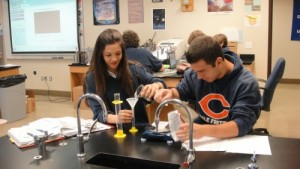Science SSEP 1 – Wine in Microgravity:
 The students designing thier project.
The students designing thier project.http://ssep.ncesse.org/communities/experiments-selected-for-flight/selected-experiments-on-ssep-mission-1-to-iss/%5B/caption%5D
“Describe the experiment (who, what, from where, when, why)?”
Alhan: A: The creators of the project were from Claminade college preparatory who were in grade 9 and 10. Max Holden and Paige D’Andrea were the creators of the project. Their idea was to create Microgravity wine, and this experiment was to test the speed of fermentation of wine when exposed to microgravity. They created it in West Hills, California on December 13 and 14, 2011. They chose this experiment because when something is in microgravity its at a constant free fall so it will constantly move the grape juice and yeast. When the sugar in the grape juice is mixed with the yeast it will ferment and produce ethyl alcohol and carbon dioxide. They wanted to see if it will speed up the process or slow it down.
“Retell the team’s background research.”
Kaleb: B: They had to research: the average ratio of grape juice to yeast and d how long it has to ferment. They also had to find how much formalin was needed for the top stop the experiment. To find d that they had to have enough formalin compared to the amount of liquid they had. After 5 days of testing and research they found the perfect amount. Other than that they just did a lot of testing.
“Explain what the experimental and control groups were and what the difference was.”
Olivia: C: The control groups were the ratio of grape juice and yeast, and the amount of formalin that was needed to stop the experiment. The experimental groups were the amounts of carbon dioxide (with Titration Kit), and weighing the sediment to test the ethyl levels of the alcohol. The difference between the experimental group and the control group is that with the experimental group, you have to test how much you need, and try it before coming to a one hundred percent conclusive result of the measurements and amounts of what you need. Control is something that you can know the exact measurements of, and not having to try to figure it out on your own. So this substance can be weighed without question.
“Is there any other extra information on this project?”
Olivia: D: Their idea works by using microgravity and the lack of oxygen to their advantage. The lack of oxygen will create ethyl alcohol. Microgravity is used to create a constant freefall for the substances to keep moving together because of microgravity. They used this to find out weather the wine would be created faster or slower. To find this out, they used the experiment in microgravity and the one on earth to find out which one creates more carbon dioxide. The yeast, sugar, and grape juice will create the ethyl alcohol and carbon dioxide.
“Why do you think the group won?”
Olivia: I think that the students won, because the experiment is a different idea, and that the idea of using microgravity as a constant freefall moving the cells constantly, can be used to our advantage. If the wine was created faster in microgravity, then we could be able to create new substances, and produce more substances, faster rather than on earth.
Alhan: I feel like the students won a place because their experiment was about something not many people think about and that is fermentation of grapes and the process of wine. The idea that the process of the fermentation can change to a different speed when exposed to microgravity seems very interesting.
Kaleb: I think they won because they had a interesting and well researched topic that was intriguing so maybe the judges thought it was as good as I think it is.